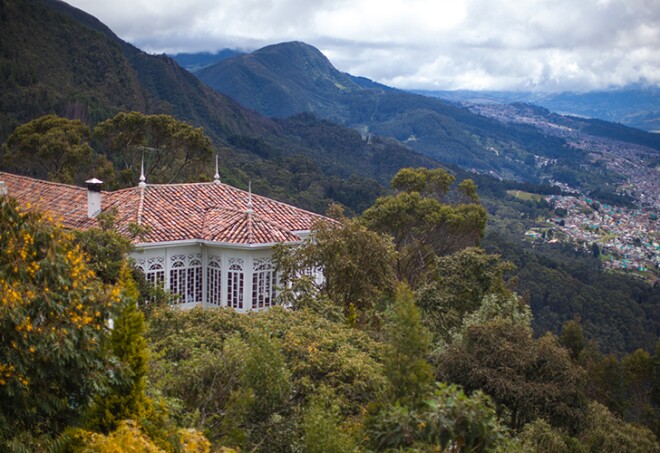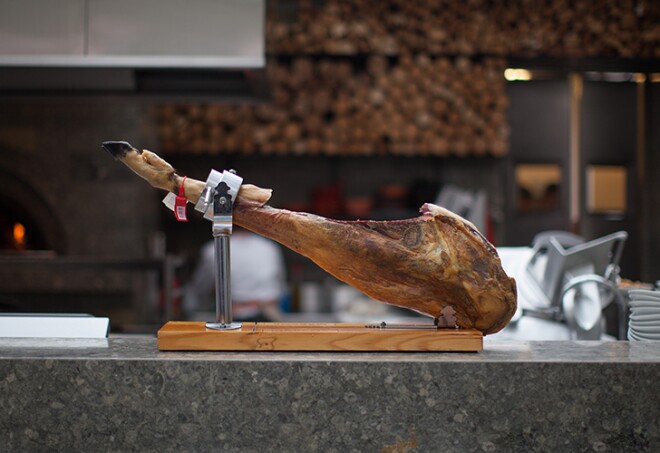Essential Guide to Bogotá
Two colors will be top of mind after a visit to Colombia’s capital city: green and gold. The green of the city’s parks and South America’s Andes in the distance. The gold at the Museo del Oro. Spend time walking around the city, there’s plenty to marvel at over the colonial architecture along the way. Two day trips from Bogotá that, really, aren’t optional: Lake Guatavita, for natural beauty and the stories of chieftains and conquistadors; and The Salt Cathedral, sculpted from the empty chambers of a working salt mine.
Highlights
Monserrate Bogotá, Colombia
The peak called Monserrate towers over central Bogotá and lends its name to the church that tops it. Perched more than 10,000 feet above sea level, the sanctuary—dedicated to the Passion of Christ—has beautiful gardens showcasing marvelous highland vegetation, and the city views from here are spectacular (sunsets are especially recommended). Ascend Monserrate by cable car, via railway, or on foot (this last is only for the fittest and those already acclimated to the altitude). That beautiful white house on the mountainside is Casa Santa Clara restaurant, a better-than-expected, special-occasion-suitable venue at which to try traditional Bogotá favorites like ajiaco, a thick potato-and-chicken soup.
Carrera 6 No.15-88, Bogota 110321, Colombia
Bogotá’s museum of all things gold is one of Colombia’s greatest treasures. Yet despite the name, you’ll find more here than just the precious metal. In addition to stunning displays drawing on a collection of more than 30,000 gold treasures, you’ll find highlights from the institution’s more than 20,000 artifacts of clay, textiles, and other materials that reveal the history of Colombia’s diverse pre-Hispanic cultures. Audio guides enhance the experience with information on the objects’ purpose and provenance that connects various periods and movements. The museum shop offers dazzling (if somewhat expensive) souvenirs fashioned by members of Colombia’s many indigenous nations.
Cl. 11 #4-41, Bogotá, Colombia
Set within the Banco de la República’s museum complex, the Botero Museum offers a sampling of paintings and sculptures by famed Colombian artist Fernando Botero, best known for his still lifes and his exaggeratedly rotund human figures. Botero donated 123 of his own pieces to the institution, as well as 85 from his personal collection—including treasures by Chagall, Picasso, Monet, and Miró. The gracious colonial-era mansion includes an area that displays contemporary Latin American and European artworks. Audio guides are available in English, French, and Spanish.
Dg. 68 #1242, Bogotá, Colombia
After more than a decade as one of the Bogotá art scene’s nerve centers—in addition to being a Pan-American landmark—Nueveochenta, founded by former Colombian president César Gaviria, now operates out of a house from the 1960s recently restored by Colombian architect Luis Restrepo. The building’s “patio” is a canvas in itself, for site-specific, outdoor works that complement what can be seen indoors. A bookstore and a documentation center are both open to the public.
Parque De La Sal, Zipaquirá, Cundinamarca, Colombia
About an hour north of Bogotá lies the so-called Salt Cathedral, an intriguing and impressive church that has been sculpted from the empty chambers of a working salt mine, one that’s been in operation since pre-Hispanic times. Beginning in the 20th century, miners began to decorate shafts with icons and saints from whom they sought protection. By 1954, a full-fledged cathedral had been carved into the rock and inaugurated; it has been attracting visitors from all over the world ever since. When a previous sanctuary became unstable, the current chapel was carved almost 200 feet deeper down and opened in 1995, complete with eerie lighting and beautiful sculptures. A visit is a moving experience even for nonbelievers.
This lake set amid lofty mountains is a mystical, peaceful spot with a fascinating history of indigenous princesses, gold-covered chieftains, and treasure-gouging conquistadors—purportedly the site where the El Dorado legend began (indeed, gold artifacts have turned up on the shores). Colombian guides can explain the local history, recount famous tales, and identify the highland vegetation you pass as you wind up a trail to the stunning lagoon. Its perfectly circular shape once fueled speculation that it is a volcanic crater or the result of a meteorite impact, but it’s been found to have been formed from a sinkhole. The lake’s located about two hours outside Bogotá; the drive to get there crosses some beautiful country.
Calle 11
Near Plaza de Bolívar in the colonial Candelaria quarter, the city’s historic core, swing by La Puerta Falsa, a bakery and restaurant that has been run by the same family since 1816. Order the chocolate completo, a cup of hot cocoa mixed with water and melted cheese that comes with buttered bread and an almojábana (biscuit). Calle 11 No. 6–50, 57/(0) 1-286-5091. Image: William Neuheisel/Flickr.com
Cra. 9 #75-70, Bogotá, Colombia
Chef Harry Sasson is nothing short of an institution in Colombia’s culinary realm, one of the people responsible for having reactivated a local interest in haute cuisine. Mixed-grill aficionados will thrill equally to his langoustines (with mushrooms and cashews in a sweet-and-sour sauce) as they will in the sweetbreads (done in parsley, garlic, and oregano). But you’ve also got the perennial house-smoked grouper, or duck that’s cooked twice to make sure every piece achieves just the right consistency. A great wine list and a merry mood overall make any dinner at this historic residence on Carrera 9 a memorable one.
Calle 69a # 5-75, Zona G, Bogotá, Colombia
Once a quiet residential neighborhood near Bogotá’s financial district, Zona G (as in gourmet) is now an all-city dining hot spot that’s abuzz day and night, serving everything from upscale burgers (at Gordo) and pizzas (at Julia) to fine dining (at Criterión) and great brunches. The area outpost of Juan Valdez Café is Bogotá’s loveliest and liveliest. Zona G sprawls over several blocks surrounding the intersections of Calle 70 and Carrera 5.
Cl. 10 #5-72, Bogotá, Cundinamarca, Colombia
In the historic Candelaria district, the 42-room Hotel de la Ópera occupies two colonial townhouses and parts of a 1940s art deco mansion. Head up to the rooftop restaurant, El Mirador, to enjoy ajiaco (potato soup with corn, chicken, and aji chili) along with views of the city’s main cathedral. From $162. 57/(0) 1-336-2066. This appeared in the August/September 2013 issue. Image courtesy of Hotel de la Ópera
Cl. 79b, Bogotá, Colombia
Calle 79b (between Carreras 7a and 9a) is a favorite Bogotá destination, where restaurants, indie galleries, design stores, bars, and, above all, antiques shops come together. A visit to the Zona Rosa isn’t complete without a stroll down this street in search of treasures and collectibles. Prices can be expensive, but some surprise is always on sale. At the end of the drag, on the corner with Carrera 7a, a prize awaits: El Bandido, one of the coolest gin joints in the entire capital.
11-75 Calle 82
Aficionados of the high-end love the window-shopping and elegant eating in Zona T. Retail therapy reaches a peak at the Centro Andino and El Retiro shopping malls, chockablock with glitzy boutiques hawking refined Colombian and foreign labels; customers then pop into elegant dining rooms serving up dishes that range from Southeast Asian and Italian to local and other Latin American cuisines. Not tired yet? Try a craft cocktail at one of the district’s fashionable watering holes, if you can find a space amid the well-scrubbed, easy-on-the-eyes jeunesse dorée.





















